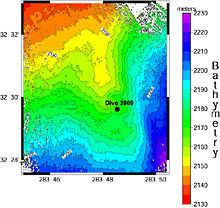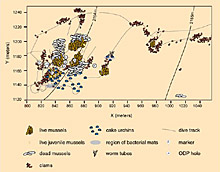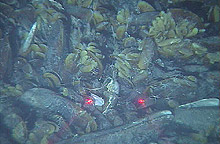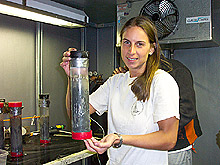
This map shows the results of a Seabeam survey of the Blake Ridge Diapir, the location of the next two DSV Alvin dives. Image by C. Ruppel. Click image for larger view.
Windows at Blake Ridge Diapir
July 26, 2003
Taconya Piper, Web Coordinator
NOAA Office of Ocean Exploration
The next two dives will occur at the Blake Ridge Diapir, a site known for its concentration and diversity of seep organisms (for example, mussels and clams), hydrate occurring close to the seafloor, and other features such as bacterial mats. This site was drilled during Ocean Drilling Program (ODP) Leg 164 ![]() and was also the focus of four Alvin dives during a 2001 NOAA/NURP cruise in which co-Chief Scientists Drs. Ruppel and Van Dover were key participants.
and was also the focus of four Alvin dives during a 2001 NOAA/NURP cruise in which co-Chief Scientists Drs. Ruppel and Van Dover were key participants.
The objectives of today’s dive, number 3909, were to collect live clams and worms in tubes, sample mussel beds, photo-document any seafloor methane hydrate occurrences, and deploy markers to guide future dives.

This map of the Blake Ridge Diapir shows the distribution of seep organisms, Alvin dive tracks, Ocean Drilling Program (ODP) sites (A through E, circle symbols), and markers (B through E, pie-shaped symbols) during dives in 2001 (Van Dover et al. (2003) Deep-Sea Research I 50, p. 287). Click image for larger view.
The Blake Ridge Diapir site was absolutely teeming with life. This dive provided scientists with an opportunity to sample biota from the outer reaches of previously surveyed areas, as well as return to well known sites. Samples of dense giant mussel beds, clam beds, worms in tubes, and bacterial mats were acquired. This was such an exciting dive that even experienced Alvin pilot Bruce Strickrott, who has been with the program more than seven years, was amazed by all that was seen and collected.
The mussels were of mixed sizes and condition (live and dead), and the largest individual collected was 240 mm long! Sections of the digestive tract were taken for histological analysis for a study of mussel parasites. A pathogenic virus was discovered in mussels collected from this site in 2001 by graduate student Megan Ward in Dr. Van Dover’s lab. These new samples will be used to assess the progress of the disease in the mussel population and to characterize the virus more completely.

Bed of adult and juvenile mussels observed on the seafloor (approximately 2160 meters water depth) during the dive. Image by WHOI. Click image for larger view.
SeaBeam and subbottom profiling (3.5 kHz) data are acquired each evening to create detailed maps of the dive sites. Nominal sediment penetration of the acoustic signals from the 3.5 kHz system is 30 meters, with better penetration at some locations.
Stay tuned for more exciting information on Windows to the Deep and upcoming Alvin dives!

Graduate Student Taylor Heyl holding a push core from the submersible Alivn. Click image for larger view.
Microbial Diversity in Deep-Sea Sediments at the Blake Ridge Diapir
Taylor Heyl
Graduate Student
Department of Biology, W&M
Today I dove to 2168 meters on the Blake Ridge Diapir with microbiologist Heath Mills from Georgia Tech and Alvin pilot, Bruce Strickrott. This dive to a methane hydrate seep site was designed to explore the geology, biology and geochemistry of the diapir discovered in 2001. For my master’s thesis I am interested in the relationship between sediment geochemistry and reproductive condition of Vesicomyid clams living at the seep site. In order to compare environmental conditions at clam beds, we needed to sample four different microhabitats: live clam beds, dead clam beds, a mixture of live and dead clams, and a site with no clams present at all. These habitats were sampled using sediment push cores operated by manipulator arms on the submersible Alvin.
Alvin was deployed from the ship at 08:00 and took about an hour to sink to the bottom. The sub normally sinks without power but on this dive the pilot was forced to drive through the water column as we were sinking because of a strong surface current from the Gulf Stream at about 200 meters. We lost some power driving to the bottom and would have to sample efficiently once we found the site. Alvin landed on muddy sediment rippled from bottom currents and covered with small patches of clams. Using a map that had been drawn from the previous dives at this site and markers that had been placed on the seafloor, we found what appeared to be a good sampling area, and the pilot began collecting sediment in push cores.
Heath and I recorded video of the site and observed from the view ports as the cores were gently placed over clam beds and pushed into the sediment, coming back filled with dark mud and small white clams at the surface. We flew over fields and fields of mussel beds, white bacterial mats, and abyssal plains with squat lobsters, octopus, sea cucumbers, and brittle stars on the outer edges. At the end of the dive we drove up to a slight depression where methane hydrate could be seen lying underneath an overhang of sediment. This formation is of great interest to the geologists on this cruise. We left it undisturbed for the next dive.
It was difficult, while peering out the viewports of Alvin, to get a good image of individual clams. Many of the clam beds were filled with dead clams, their shells lying open, and finding a site with live clams became a hard task. After 24 sediment cores had been sampled, Alvin was almost out of power. The dive had been mainly work-related but for the last few minutes before we dropped weights and began the ascent to the surface, we explored the outer edges of the seep site, flying over small hills and depressions, staring through the view ports at life in the abyss.
The ride back up was relaxing since our samples had been collected and were secured to the science basket on Alvin. We peered out the view ports at the bioluminescent light show as we lifted toward the surface and watched the ocean change from complete darkness to shades of blue and then to the blinding clear surface water.
Alvin was escorted back to the R/V Atlantis by a small inflatable boat and lifted back on deck where scientists waited to greet the divers and look through the samples in the basket. It was a spectacular view.


















